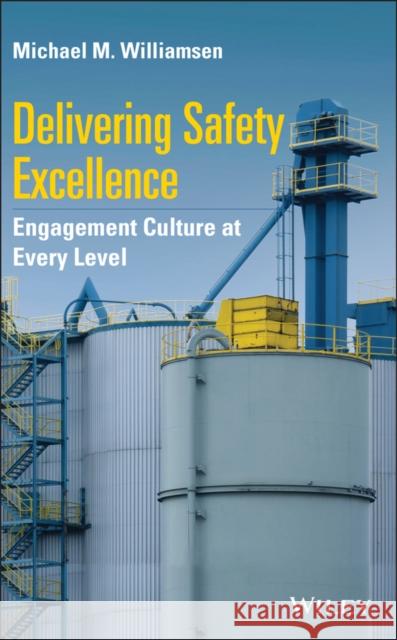Delivering Safety Excellence: Engagement Culture at Every Level » książka



Delivering Safety Excellence: Engagement Culture at Every Level
ISBN-13: 9781119772132 / Angielski / Twarda / 2021 / 272 str.
Delivering Safety Excellence: Engagement Culture at Every Level
ISBN-13: 9781119772132 / Angielski / Twarda / 2021 / 272 str.
(netto: 420,54 VAT: 5%)
Najniższa cena z 30 dni: 423,94 zł
ok. 22 dni roboczych.
Darmowa dostawa!
Acknowledgements xiAuthor Biography xiiiList of Figures xvPreface xixPrologue xxiIntroduction xxvPart I 11 The Funeral 3Notes 102 No Support for Safety 113 The Tyranny of the Urgent 154 No Pay for Safety 21Note 245 Weak Culture Miseries 256 Injury Plateau 27Limitations of Safety Observation Sampling 28Note 297 A Brief Safety History 318 Beyond Accident Reaction 39Note 44Part II 459 Safety Culture Beginnings 47Notes 5410 More Safety Culture 5510.1 Background for Culture Improvement 6110.2 Human Interaction Realities 6311 Active Resistance 6912 Zero Injuries 7513 How Long? 8513.1 POP Statement 8913.2 Action Item Matrix (AIM) 9113.3 Workers' Compensation Carrier Claim Processing Procedure 9214 World-Class Safety 97Note 10115 Watch Out 10315.1 Setting Priorities 10315.2 Management Reluctance to Be Involved 10415.3 Regulatory Audits 10515.4 Team Inclusiveness 10515.5 The Importance of Good Data and a Solid Improvement Process 10615.6 The Need for a Challenging Time Line 10715.7 Urgency Followed by Complacency 10815.8 Series or Parallel Problem Attack Process 10915.9 The Importance of Viable Metrics 111Note 112Part III 11316 Moving Forward to Safety Culture Excellence 115Note 12017 The Critical Safety Steering Team 12118 The RIW Process 13318.1 Rapid Improvement Workshop Teams 13518.2 Delivering a Better Safety Performance 13919 Fundamentals That Are a Result of Developing a Culture of Safety Excellence 141Note 14620 Communication and Recognition 14720.1 Encouraging Positive Behavior 149Notes 15121 Hazard Recognition Is Different than Hazard Control 15321.1 The Common Threads 15421.2 Overestimating Personal Capabilities 15521.3 Complacency - Familiarity with the Task 15721.4 SafetyWarnings - the Severity of the Outcome 15721.5 Voluntary Actions and Being in Control of Them 15921.6 Personal Experience with an Outcome 16021.7 Cost of Noncompliance 16121.8 Overconfidence in the Equipment 16121.9 Overconfidence in Protection and Rescue 16321.10 Potential Profit and Gain from Action 16421.11 Role Models Accepting Risk 16522 The Trap of Complacency 169Epilogue 173A The History of the Continuous Excellence Performance (CEP)/Zero Incident Performance (ZIP) Process 177B The Railroad Study by Petersen and Bailey 181Using Behavioral Techniques to Improve Safety Program Effectiveness 181B.1 MR Study of Safety Program Effectiveness 182B.1.1 Phase I - 1979-1983 182B.1.2 PHASE II - 1985-1988 183B.1.2.1 Study Overview 183B.1.2.2 Participants in Study 184B.1.2.3 History - Need for Study 185B.1.2.4 Three Management Approaches to Safety Programming 187B.1.2.5 Philosophies Underlying Three Approaches to Safety Programming 187B.1.2.6 Development of the Study Format 188B.1.2.7 Assumptions to be Tested 194B.1.2.8 Safety Program Activities Survey 194B.1.2.9 Involvement of Top Railroad Safety Officers 195B.1.2.10 Pilot Survey - Railroads I and II 195B.1.2.11 AAR Study Group Analysis 197B.1.2.12 Aberdeen Study Group Analysis 198B.1.2.13 Further Refinement of the Survey Process 199B.1.2.14 Survey Verification Study - Railroads III and IV 200B.1.2.15 Description of Analysis Program 201B.1.2.16 Analysis and Use of Survey Data by Managements 202B.1.2.17 Testing a Human Behavioral Factors Approach 204B.1.2.18 Technique to Measure the Effects of the Experimental Program 204B.1.2.19 Training Format - Railroads I and II 205B.1.2.20 Results of Positive Reinforcement - Railroads I and II 206B.1.2.21 Verification of Results on Railroads III and IV 207B.1.2.22 Reductions in Unsafe Behaviors 208B.1.2.23 Summary of Positive Reinforcement Experimental Results 208Impact of Study - Four Railroads 209B.2 Railroad I 209B.2.1 Background 209B.2.2 Impact of Study 210B.3 Railroad II 210B.3.1 Background 210B.3.2 Impact of Study 210B.4 Railroad III 211B.4.1 Background 211B.4.2 Impact of Study 211B.5 Railroad IV 211B.5.1 Background 211B.5.2 Impact of Study 212B.5.2.1 Longer Term Use of Positive Reinforcement 212B.5.2.2 Study Conclusions and Outcomes 213B.5.2.3 A FinalWord 214Appendix 1: Sample - Chart Used for Analysis on One of the Study Railroads 214Appendix 2: Sample - Chart Used for Analysis on One of the Study Railroads 216Appendix 3: Sample - Chart Used for Analysis on One of the Study Railroads 217Appendix 4: Sample - Chart Used for Analysis on One of the Study Railroads 218Appendix 5: Sample - Chart Used for Analysis on One of the Study Railroads 219Appendix 6: Total Response - 20 Categories - 4 Railroads 220Appendix 7: Comparison of Positive Responses by Category - 4 Railroads 221Appendix 8: Comparison of Training Results - 4 Railroads 222Appendix 9: Positive Recognition Training Outline 223Appendix 10: Assessment Questions Used by Supervisors 224Appendix 11: Analysis of Responses to Pilot Survey Questionnaires for Railroads I and II. Source: Based on American association ofrailroads 225C The Charter Document 227C.1 Process and Objectives (Outcomes) 228C.2 Scope and Authority 228C.3 Roles and Responsibilities 229C.4 Team Member Representation 229C.5 Team Safety Department Representative 229C.6 Voting and Quorum 229C.7 Team Member Service 229C.8 Team Leader Service 230C.9 Selection of Team Leader 230C.10 Meeting Frequency 230C.11 Recordkeeping 230C.12 Communication 231C.13 Team Learning Plan 231C.14 Annual Review of POP Statement (Purpose Outcomes Process) and Team Charter 231C.15 Measurables 232C.16 Effective Team Norms 232C.17 Steering Team Member Training 232C.17.1 CIT Facilitator 232C.18 Continuous Improvement Team Management 233C.19 Continuous Improvement Topics 233C.19.1 Continuous Improvement Process Implementation and Sustainability 233Index 235
Michael M Williamsen, PhD, has worked as a turnaround specialist with a number of small, medium and large organizations throughout the world that were in trouble in one or more of their functionalities. Dr. Williamsen started and led a global consulting business of culture change excellence that was subsequently purchased and used globally by a global fortune 50 manufacturer. Dr. Williamsen has been published in the Journal of Safety Professionals and has published 250+ short blog articles which were edited and approved by the parent organizations. For more than a decade Dr. Williamsen has been a featured speaker at the annual American Society of Safety Professionals (ASSP) safety conference, regional safety society conferences, the ASSP Middle East Chapter safety conferences and any number of other company and industry conferences.
1997-2024 DolnySlask.com Agencja Internetowa
KrainaKsiazek.PL - Księgarnia Internetowa









